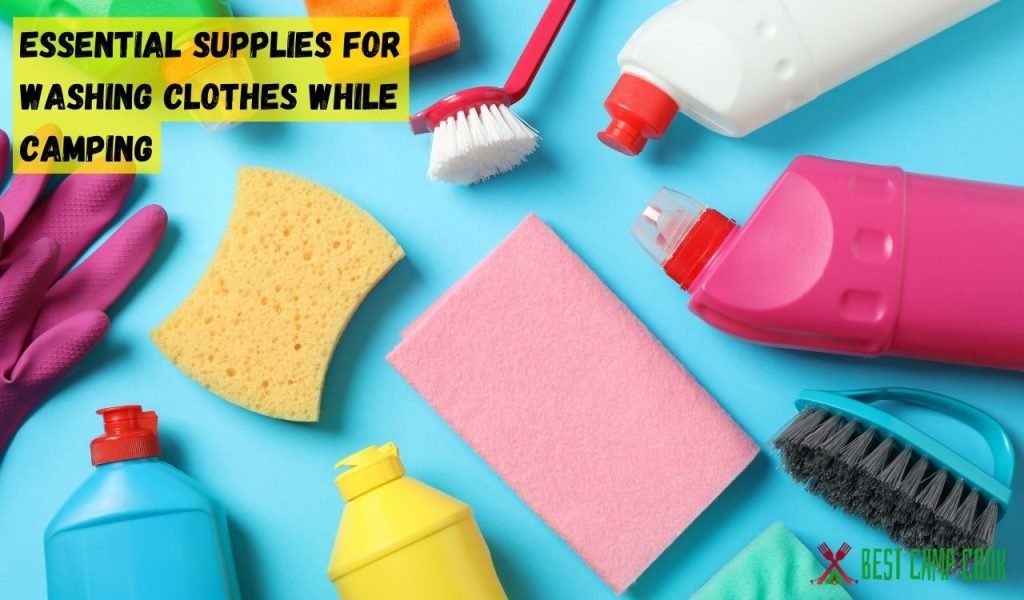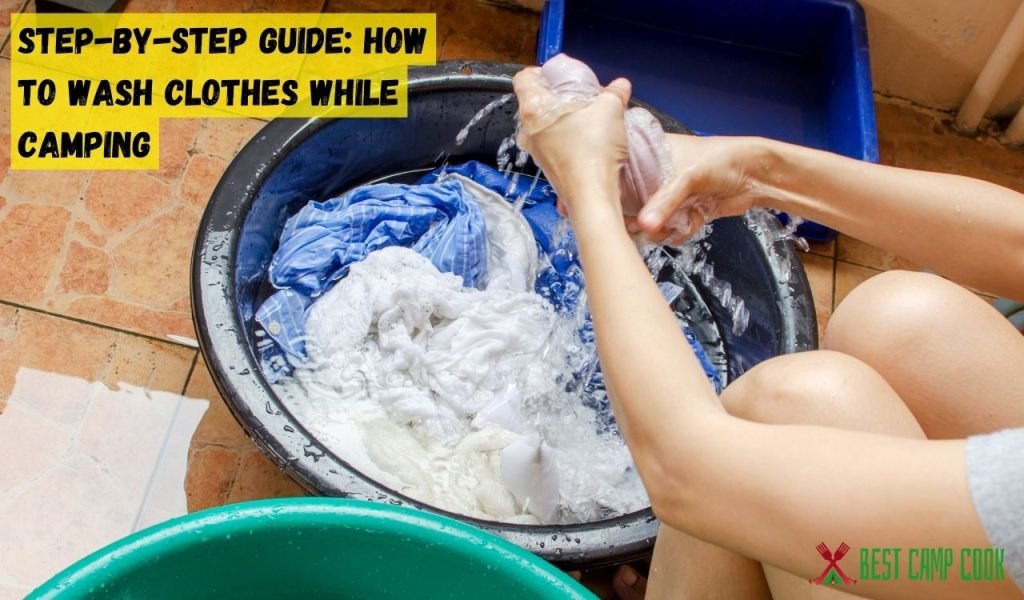Physical Address
304 North Cardinal St.
Dorchester Center, MA 02124
Physical Address
304 North Cardinal St.
Dorchester Center, MA 02124

Are you planning an adventurous camping trip and wondering how to tackle the laundry situation? Well, fret not! We’ve got you covered with our ultimate guide on how to wash clothes while camping. Say goodbye to dirty clothes and hello to fresh, clean garments in the great outdoors. Discover practical tips, clever hacks, and alternative methods that will make your camping laundry a breeze.
Whether you’re a seasoned camper or a first-timer, this guide is packed with valuable insights to keep your clothes fresh and ready for your next adventure. So, grab your camping gear and get ready to master the art of washing clothes while camping!
Main Summary: How to Wash Clothes While Camping?
To wash clothes while camping, use a portable washing machine, eco-friendly biodegradable detergent, scrub brush, and mesh bags. Air dry in the shade, conserve water, and embrace eco-friendly practices for a greener camping experience. Follow our simple guide to keep your garments fresh outdoors!
Camping is a wonderful way to reconnect with nature, but it doesn’t mean you have to sacrifice cleanliness and hygiene. With a few essential supplies, you can keep your clothes fresh and clean even in the great outdoors.

Investing in a portable washing machine can make a world of difference when it comes to washing clothes while camping. These compact devices are designed specifically for outdoor use and require minimal water and electricity. Look for models that are lightweight, easy to transport, and have a capacity suitable for your needs.
Opt for biodegradable detergent to minimize your impact on the environment. Many camping and outdoor stores offer eco-friendly detergent options that are specifically formulated for use in natural settings. These detergents are gentle on fabrics and won’t harm the surrounding ecosystems when you dispose of the wastewater.
A collapsible basin or bucket is a versatile tool that can serve multiple purposes while camping. It can be used as a makeshift washing machine, allowing you to soak and agitate your clothes. When not in use, it folds down to a compact size, making it easy to pack and carry.
To effectively remove dirt and stains from your clothes, consider bringing a scrub brush or rubbing pad. These tools help in loosening and lifting dirt particles from the fabric. Choose a brush or pad with soft bristles or surfaces that won’t damage your clothes.
Accidents happen, and stains are inevitable, especially when you’re enjoying outdoor activities. Pack a travel-sized stain remover specifically designed for clothing. These stain removers are usually compact and easy to carry, and they can come in handy when treating stubborn stains before washing.
Drying your freshly washed clothes is just as important as washing them. A sturdy clothesline and a handful of clothespins are essential for setting up a drying area at your campsite. Look for lightweight, durable materials that won’t take up much space in your backpack.
Using mesh laundry bags can be beneficial while camping. These bags are designed to protect your clothes during the washing process and help prevent tangling or damage. Additionally, they can be useful for organizing and separating different types of garments, such as delicates or socks.
Having a reliable water container or jug is crucial for camping clothes washing. It allows you to transport water from a water source to your washing area efficiently. Look for containers with secure lids or spouts to prevent leaks and spills.
If space allows, consider bringing a collapsible drying rack or lightweight hangers. These items provide an alternative drying method, especially when you have limited options for hanging clothes. Drying racks are particularly useful for larger items like towels or pants.

Washing clothes while camping doesn’t have to be a daunting task. With a simple step-by-step approach, you can keep your garments clean and fresh, even in the wilderness. Follow these guidelines to ensure a successful clothes washing experience:
Choose a suitable location for your washing area. Look for a flat surface near a water source, such as a river or a campground’s designated washing area. Ensure that the area is clear of debris and rocks that could damage your clothes or washing equipment.
Before starting the washing process, sort your clothes into different piles based on their color, fabric type, and level of dirtiness. This will help prevent color bleeding and allow you to adjust the washing method accordingly. Take a moment to pre-treat any stubborn stains using your travel-sized stain remover, following the instructions provided.
If you have a portable washing machine, follow the manufacturer’s instructions to fill it with water. If you’re using a collapsible basin or bucket, fill it with enough water to cover your clothes. Ensure that the water is at a comfortable temperature for washing.
Measure the appropriate amount of biodegradable detergent for the size of the load you’re washing. Consult the instructions on the detergent bottle for guidance. Add the detergent to the water and mix it thoroughly to create a soapy solution.
Place your sorted clothes into the water and agitate them gently with your hands or a scrub brush. Pay special attention to areas with stains or heavy dirt. Continue agitating for a few minutes to allow the detergent to penetrate the fabric and remove dirt particles.
Once the clothes have been adequately washed, drain the soapy water from the portable washing machine or basin. Refill it with clean water for rinsing. Agitate the clothes again to remove any remaining detergent residue. Repeat this step if necessary until the water runs clear.
After rinsing, carefully lift each garment out of the washing machine or basin, allowing the excess water to drain. Gently squeeze the clothes to remove additional moisture without wringing or twisting, as this can cause damage to the fabric.
Transfer your damp clothes to a drying rack, clothesline, or hangers, ensuring proper air circulation. Hang them in a shaded area to protect them from direct sunlight, which can fade colors and damage certain fabrics. Allow the clothes to air dry completely before folding or wearing them.
Clean and dry your portable washing machine, collapsible basin, scrub brush, and other washing supplies before storing them. This will help prevent mold and mildew growth and ensure they are ready for your next laundry session.

After washing your clothes while camping, the next crucial step is drying them effectively. Without access to a traditional dryer, you’ll need to rely on alternative drying methods. Here are some practical and efficient techniques for drying your clothes while camping:
Air drying is the most common and straightforward method for drying clothes while camping. Hang your freshly washed garments on a clothesline or a suitable drying rack. Choose a shady area to prevent direct sunlight, which can fade colors and damage fabrics. Ensure that the clothes are adequately spaced to allow for proper airflow, promoting faster drying.
If your camping site doesn’t provide a clothesline, you can create your own using a sturdy rope or cord. Find two trees or anchor points, and tie the line tightly between them. Clip your clothes onto the line using clothespins or makeshift clips, ensuring they are evenly spaced. This method is ideal for lightweight items like shirts, socks, and underwear.
Take advantage of natural elements in your surroundings to expedite the drying process. If it’s a windy day, hang your clothes in an open area where the wind can help dry them faster. The natural breeze aids in evaporation, especially for lightweight fabrics. Similarly, if you’re camping near a body of water, such as a lake or river, you can use the natural warmth and airflow near the water to aid in drying.
For smaller items like underwear, socks, or handkerchiefs, towel drying can be effective. Lay a clean, absorbent towel on a flat surface, place the damp clothes on top, and roll them up tightly together. Apply gentle pressure to the rolled towel, squeezing out excess moisture from the clothes. Repeat the process with a dry towel if necessary. Remember to use a towel that you don’t mind getting slightly damp.
If you’re in a rush or have limited space, wearing your clothes to dry them is a practical option. Put on the damp clothes and allow your body heat and movement to facilitate the drying process. This method works best for lightweight garments like T-shirts, shorts, or leggings. However, avoid wearing wet clothes in cooler weather or at night to prevent discomfort and potential health issues.
If you have a campfire or a portable heater, you can use the warmth to dry your clothes. Hang them near the fire but at a safe distance to avoid direct exposure to flames. The radiant heat will help speed up the drying process. Be cautious not to place delicate or synthetic fabrics too close to avoid damage from excessive heat.
For items that need extra care or are made of delicate fabrics, wrapping them in absorbent towels can help absorb moisture more gently. Lay a towel flat, place the damp garment on top, and roll them together. Press lightly to extract excess water without causing damage. Replace the towel with a dry one if needed. This method is particularly useful for wool, silk, or other sensitive materials.
Plan your laundry routine wisely, considering the weather and the time required for drying. If rain is expected or if you’re camping in a humid environment, allow for extra drying time. Start the washing process early in the day to maximize daylight hours and ensure that your clothes have ample time to dry thoroughly.

When washing your clothes while camping, it’s essential to minimize your environmental impact and practice eco-friendly methods. By following these best practices, you can maintain cleanliness while being mindful of the environment:
Choose a biodegradable detergent specifically designed for outdoor use. These detergents are formulated to be eco-friendly and break down naturally without harming the environment. Avoid using regular household detergents that may contain harmful chemicals and pollutants.
Conserve water by using low-impact washing methods. Rather than filling a basin or tub, consider using a collapsible bucket or sink that requires less water. Use just enough water to cover the clothes, and if possible, reuse the water for other cleaning purposes, such as washing dishes or cleaning camping equipment.
Be mindful of water usage while washing your clothes. Only wash essential items that are truly dirty or soiled. If a garment can be worn for a longer period without compromising hygiene, consider postponing its washing to save water. Spot cleaning stains or using natural remedies like baking soda or vinegar can help refresh clothes without a full wash.
Opt for cold water when washing your clothes while camping. Heating water requires additional energy, so washing in cold water reduces your environmental impact. Most camping detergents are designed to work effectively in cold water, making it a practical and eco-friendly choice.
Skipping the dryer is not only eco-friendly but also saves energy. Instead of using a dryer, opt for air drying your clothes using the methods mentioned earlier. Hanging clothes outdoors allows them to dry naturally, reducing your reliance on electricity and minimizing carbon emissions.
Consider reusing water whenever possible. If you have multiple rounds of laundry, reuse the water from the previous wash to rinse the next load. Additionally, after washing your clothes, collect the greywater (used laundry water) and repurpose it for other campsite needs, such as cleaning or watering plants.
Minimize the need for frequent laundry by packing light and choosing quick-drying clothes. Opt for lightweight and moisture-wicking fabrics that dry quickly, reducing the amount of time and resources needed for washing and drying.
Adhere to the Leave No Trace principles, which promote responsible outdoor practices. Dispose of wastewater properly, following campground guidelines or dispersing it at least 200 feet away from water sources. Avoid washing clothes directly in natural water bodies to prevent pollution and disturbance to aquatic ecosystems.
Adopt a minimalist approach to clothing while camping. Pack versatile pieces that can be mixed and matched, reducing the need for excessive laundry. Embracing a simpler wardrobe not only saves time and effort but also reduces the environmental impact of your camping trip.
Washing clothes while camping can be a challenging task, but with the right approach and a bit of troubleshooting, you can overcome common issues that may arise. Let’s explore some potential problems and their solutions:
One common issue campers face is a limited water supply for laundry. If you find yourself short on water, consider these solutions:
Forgetting to pack essential washing equipment can pose a challenge. Here are a few alternative methods to consider:
Dealing with stains and odors can be tricky while camping. Try these solutions to keep your clothes fresh and clean:
When camping, time and space constraints can make laundry challenging. Here are some additional tips to troubleshoot these common issues:
Drying clothes effectively can be a challenge while camping, especially in humid or rainy environments. Consider these solutions:
Camping often involves outdoor activities that can result in heavily soiled clothes. Here are a few strategies to tackle excessive dirt and mud:

While a traditional washing machine may not be readily available, there are alternative methods to get your clothes clean and fresh during your camping trip. Let’s explore a few options:
Hand washing is the most accessible and widely used method for washing clothes while camping. Follow these steps:
Bucket washing is a simple and effective alternative method for washing clothes while camping. Here’s how you can do it:
If you’re camping near a stream or lake, you can utilize these natural water sources to wash your clothes. Here are some guidelines to follow:
If you’re willing to invest in a camping gear upgrade, portable washing machines can offer a more convenient and efficient way to wash clothes while camping. These compact machines are designed specifically for outdoor use and are powered by electricity or manual operation. They come in various sizes and capacities, allowing you to wash larger loads of laundry. Follow the manufacturer’s instructions for proper usage and maintenance of the portable washing machine.
In some camping areas, you may find laundry services or laundromats nearby. These facilities provide washing machines and dryers for public use, allowing you to clean and dry your clothes more conveniently. If you prefer a hassle-free and time-saving option, consider utilizing these services when available. It’s advisable to check beforehand for the availability and location of such facilities near your camping site.

Efficient packing can make a significant difference when it comes to doing laundry while camping. Consider these tips to optimize your camping laundry routine:
Select versatile clothing items that can be worn multiple times without compromising hygiene. Look for quick-drying fabrics that are lightweight and easy to clean.
Avoid overpacking by estimating the number of outfits you’ll need for the duration of your camping trip. Packing fewer clothes reduces the amount of laundry you’ll have to do.
Don’t forget to pack the essentials for laundry:
When packing for your camping trip, it’s essential to separate your dirty and clean clothes to maintain organization and hygiene. Here are some packing tips to keep your laundry efficient:
To make camping laundry easier, pack travel-sized containers of biodegradable detergent and stain remover. These compact and lightweight products take up minimal space in your backpack while ensuring you have the necessary supplies for washing and treating your clothes.
Opt for biodegradable detergent to minimize environmental impact when washing clothes in natural water sources.
Stain remover can come in handy for treating stubborn stains before washing. Apply it directly to the stained area, following the product instructions, and allow it to sit for a while before washing.
When space is limited during camping trips, it’s helpful to utilize multi-purpose items that can serve multiple functions, including laundry-related tasks. Here are some examples:
When choosing clothes to pack for your camping trip, prioritize quick-drying fabrics. These materials dry faster and reduce the time and effort required for laundry. Look for clothing items made from synthetic fibers such as polyester, nylon, or merino wool, which are known for their quick-drying properties.
To minimize the amount of clothing you need to pack and wash while camping, plan your outfits for layering and re-wearing. This approach allows you to make the most out of each clothing item and reduce the laundry load. Here’s how you can do it:
While washing clothes while camping, it’s crucial to prioritize safety. Here are some precautions to keep in mind:
Ensure the water you use for washing clothes is clean and safe. If using natural water sources, such as rivers or lakes, consider the following:
If you need to heat water for washing, practice fire safety:
Prioritize personal safety while washing clothes:
When washing clothes while camping, it’s important to choose suitable washing locations that prioritize safety and environmental responsibility. Here are some safety precautions to consider:
To minimize your environmental impact while washing clothes in natural settings, opt for biodegradable detergents. These detergents are formulated to break down naturally and reduce harm to the environment. Avoid using regular household detergents, as they often contain chemicals that can be harmful to plants, animals, and water sources.
When washing clothes while camping, it’s crucial to dispose of wastewater properly to protect the environment and follow Leave No Trace principles. Here’s what you should do:
If you’re using hot water for washing clothes while camping, take extra precautions to avoid burns or accidents. Follow these safety guidelines:
When washing clothes in the wilderness, it’s important to be aware of wildlife and take precautions to minimize any potential conflicts. Follow these guidelines:

When it comes to washing clothes while camping, having the right laundry products can make the task much easier and more effective. Here are some expert recommendations for essential laundry products:
Opt for a biodegradable laundry detergent specifically designed for outdoor use. These detergents are formulated to be environmentally friendly, ensuring minimal impact on the surrounding nature. Look for products that are free from phosphates and other harmful chemicals.
A good stain remover can be a lifesaver when dealing with stubborn stains on your camping clothes. Look for a travel-sized stain remover that is effective on various types of stains, such as grass, dirt, food, or oil. Make sure it’s safe to use on different fabric types.
Investing in a portable washing machine can significantly simplify the laundry process while camping. These compact and lightweight machines allow you to wash your clothes efficiently, saving you time and energy. Look for models that are easy to operate and have a good capacity for your needs.
A collapsible washing basin is a practical item to have for camping laundry. It provides a convenient and portable washing station where you can soak and wash your clothes. Look for a basin made from durable and waterproof materials, with sturdy handles for easy transportation.
A sturdy clothesline with clips is essential for drying your freshly washed clothes. Look for a lightweight and adjustable clothesline that can be easily set up between trees or other supports. The clips will help secure your clothes in place, preventing them from blowing away in the wind.
Microfiber towels are not only useful for drying yourself after a shower but also for drying your clothes. They are lightweight, compact, and highly absorbent, making them ideal for camping. Carry a couple of microfiber towels to speed up the drying process and save space in your backpack.
Having separate laundry bags for clean and dirty clothes can help you stay organized during your camping trip. Use a breathable laundry bag to store dirty clothes, preventing them from mixing with your clean clothes. Look for bags with durable construction and secure closures to keep odors contained.
If you want to freshen up your clothes and remove wrinkles while camping, a portable clothes steamer is a handy tool to have. It’s compact and easy to use, providing a quick and efficient way to maintain the appearance of your garments. Look for a steamer with a travel-friendly design and a fast heat-up time.
In conclusion, knowing how to wash clothes while camping is an essential skill that can make your outdoor adventures more comfortable and enjoyable. By following a step-by-step guide and being prepared with the necessary supplies, you can maintain cleanliness and freshness even in the wilderness.
From choosing the right detergent to utilizing alternative washing methods, there are various ways to adapt to the camping environment. Remember to consider eco-friendly practices and safety precautions to minimize your impact on the environment and ensure your well-being.
By troubleshooting common issues, exploring alternative methods, optimizing packing techniques, and prioritizing safety, you can conquer the challenges of camping laundry with ease. So, pack your camping gear, embrace the great outdoors, and keep your clothes clean and ready for your next adventure!
Yes, you can wash clothes while camping even without a washing machine. There are alternative methods such as hand washing, using a portable washing bag, or utilizing natural water sources like rivers or lakes.
Essential supplies include biodegradable detergent, a collapsible bucket, a washboard or scrub brush, clotheslines or drying racks, and clothespins. You may also consider packing stain removers and a portable clothes wringer for more convenience.
To dry your clothes while camping, you can hang them on a clothesline between trees, use drying racks or hangers, or even spread them out on rocks or bushes under the sun. Ensure proper ventilation and choose a location with good airflow.
Yes, you can wash delicate fabrics while camping. Use gentle detergents designed for delicate fabrics and follow the care instructions provided by the clothing manufacturer. Consider hand washing and avoid using harsh scrubbing techniques.
The frequency of washing clothes while camping depends on various factors such as the duration of your camping trip, the availability of clean water, and the level of dirt or sweat accumulated. As a general guideline, washing clothes every few days or as needed should suffice
Yes, there are eco-friendly laundry practices for camping. Use biodegradable detergents, wash clothes in small batches to conserve water, and choose natural drying methods instead of using electric dryers. Minimize the use of disposable products and avoid washing clothes unnecessarily.
To remove stubborn stains while camping, pre-treat the stain as soon as possible using a stain remover or by applying a mixture of water and detergent. Gently scrub the stained area and rinse thoroughly. Avoid using bleach or harsh chemicals without proper access to water for rinsing.
Yes, you can wash your shoes or hiking boots while camping. Remove the laces and insoles, hand wash them using mild detergent, and rinse thoroughly. Allow them to air dry completely before reassembling.
Using natural water sources for washing clothes while camping can be safe, but it’s essential to consider the environmental impact and local regulations. Use biodegradable detergents, avoid polluting water sources, and follow Leave No Trace principles to minimize your ecological footprint.
To prevent clothes from smelling musty while camping, ensure they are completely dry before storing them. Store clothes in breathable bags or containers to prevent moisture buildup. Consider using odor-absorbing products like dryer sheets or sachets to keep them fresh.